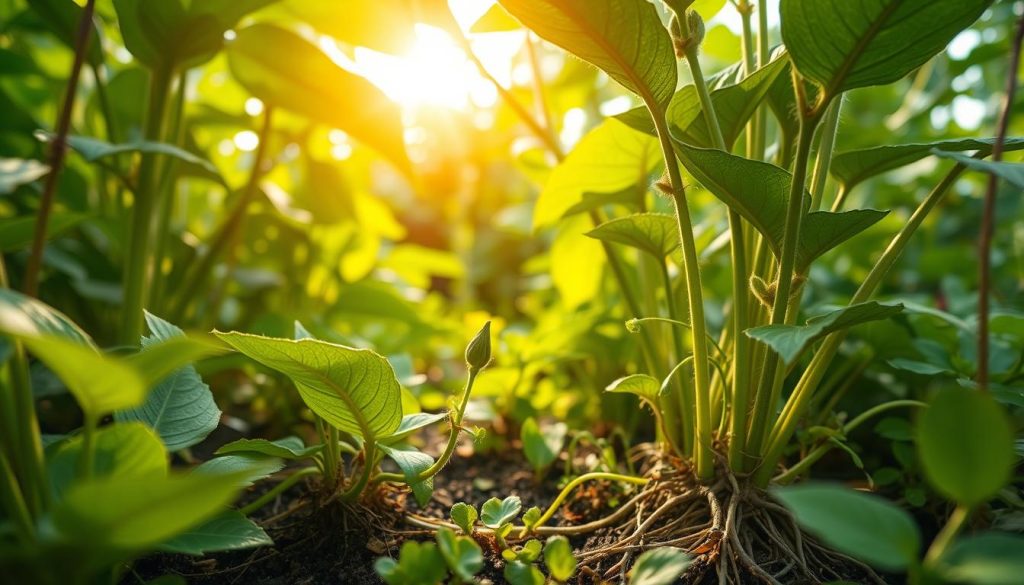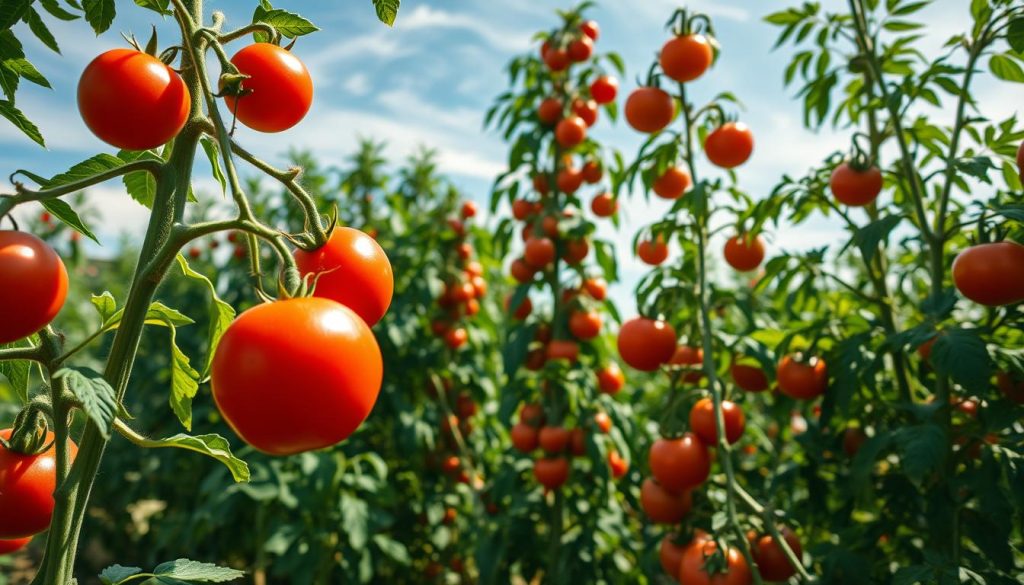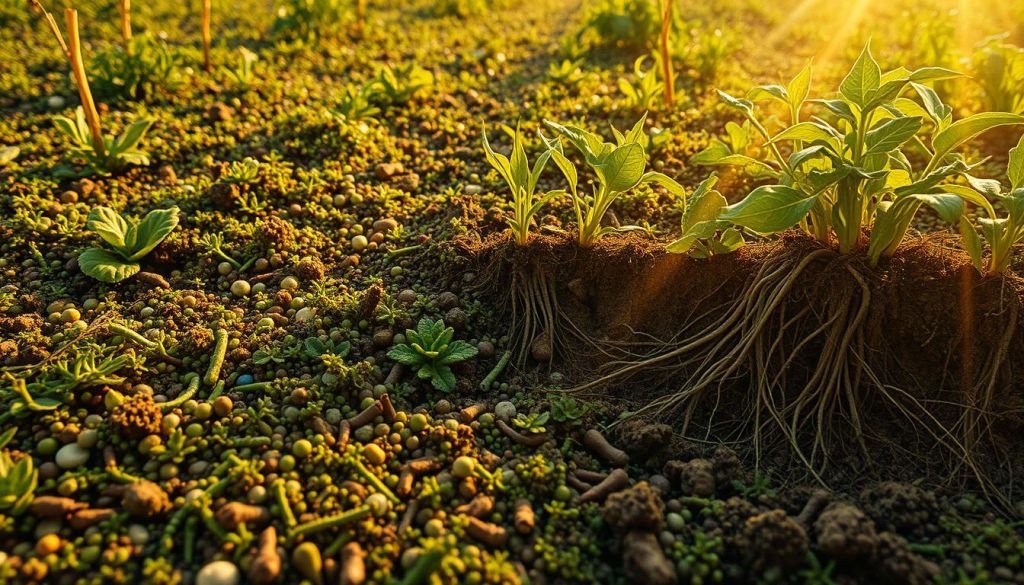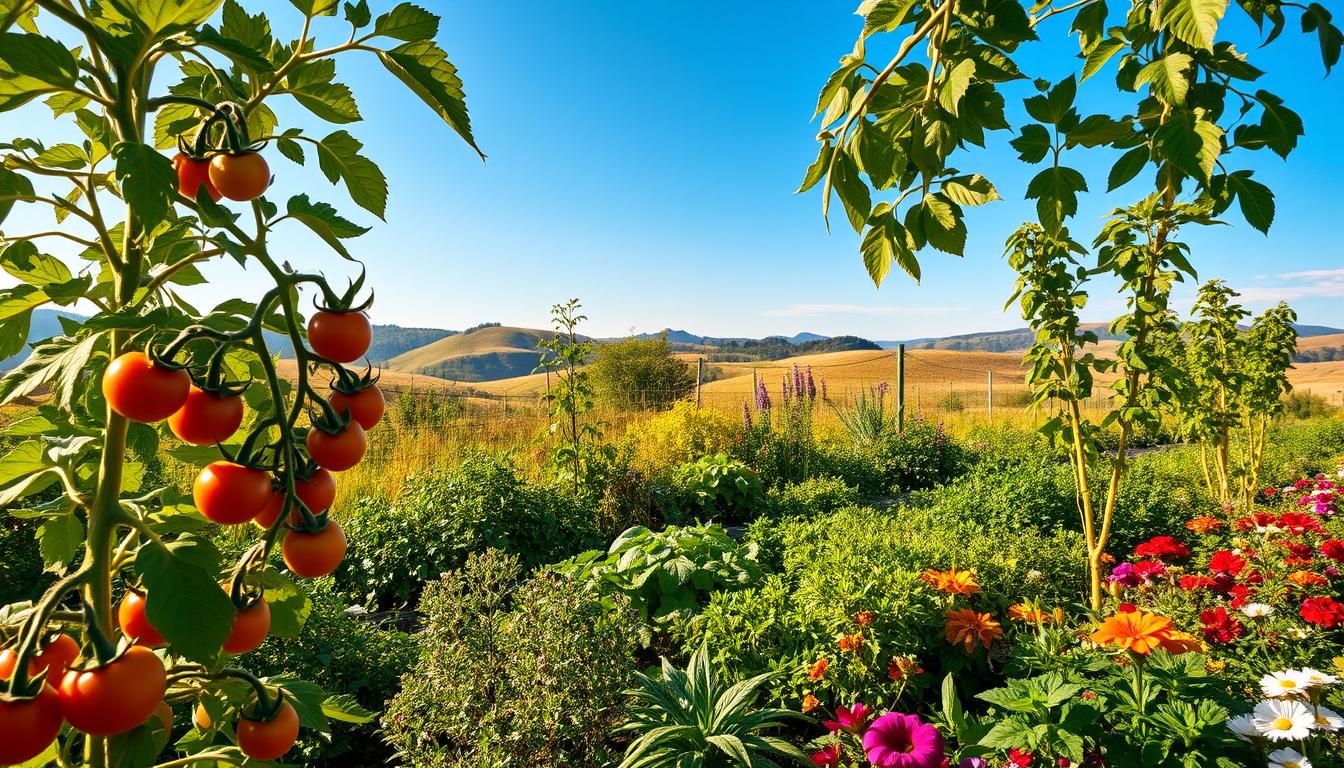Are you tired of your garden falling to powdery mildew, blight, or rust? Losing plants you’ve cared for is a common gardener’s sorrow. But, there’s a smarter way to garden that doesn’t need constant chemicals or luck.
Thanks to modern breeding, we now have plants that fight off common diseases. These varieties have natural defenses against problems that once ruined crops. They’re like plants with their own protection systems.
For gardeners at home, these tough plants change the game. They cut down on the need for harmful chemicals, saving money and the planet. Plus, they give you more reliable harvests and less worry all season long.
If you’re new to gardening or an experienced gardener, using these hardy plants is wise. It’s not just a trend—it’s a new way of gardening that works with nature, not against it.
The Silent War in Your Garden Beds
While you admire your garden, a silent war is happening. Plants fight against tiny invaders that want to take over your crops. This battle is in every garden, no matter how big or small.
Plant pathology shows that gardens face many threats from tiny enemies. These enemies try to break down plant defenses. Often, they succeed before we see any signs of trouble.
Common Plant Diseases Decimating Home Gardens
Fungal diseases are a big problem in home gardens. Powdery mildew looks like white powder on leaves. Black spot makes dark spots on roses and other plants. Late blight, known for the Irish Potato Famine, still harms tomatoes and potatoes today.
Bacterial diseases are also a big challenge. Fire blight makes apple and pear tree branches look burned. Bacterial wilt causes plants to suddenly wilt, even with enough water. These diseases spread through water, tools, and insects.
Viral diseases are the third big problem. Mosaic viruses make leaves look mottled and stunt growth. Unlike human viruses, plant viruses can’t be cured once they infect. Aphids spread these viruses, making it hard to stop them without chemicals.
The True Cost of Plant Disease Epidemics
Plant diseases are more than just a disappointment for gardeners. They mean lost time, wasted money, and broken dreams. When disease hits, all the hard work can be undone in days.
The impact goes beyond just gardens. Plant diseases cost over $220 billion a year worldwide. They raise food prices, hurt farmers, and threaten food security in some places. Growing disease-resistant plants is key to saving agriculture.
Using chemicals to fight diseases can harm the environment. These chemicals can kill good bugs, pollute water, and make diseases stronger. This creates a cycle where we need stronger chemicals to fight stronger diseases.
| Disease Type | Common Examples | Primary Symptoms | Transmission Methods | Prevention Strategies |
|---|---|---|---|---|
| Fungal | Powdery mildew, Black spot, Late blight | White powder, dark spots, water-soaked lesions | Airborne spores, splashing water | Proper spacing, morning watering, resistant varieties |
| Bacterial | Fire blight, Bacterial wilt, Bacterial leaf spot | Blackened stems, sudden wilting, water-soaked spots | Water splash, insects, contaminated tools | Clean tools, avoid overhead watering, copper sprays |
| Viral | Tomato mosaic virus, Cucumber mosaic virus | Mottled leaves, stunted growth, leaf deformation | Insect vectors, plant sap, seed transmission | Insect control, removing infected plants, resistant varieties |
| Oomycetes | Downy mildew, Pythium root rot | Yellow patches, fuzzy growth, rotting roots | Soil moisture, water splash, contaminated soil | Improved drainage, raised beds, crop rotation |
Knowing about these threats shows why disease-resistant plants are so important. By choosing plants that fight off diseases, gardeners can avoid many problems. This makes gardens healthier and helps the environment.
Disease-Resistant Plant Varieties: Nature’s Shield
Plant varieties that resist disease are a clever survival tactic from nature. Like how humans build immunity, plants have evolved to fight off pathogens. Learning about these defenses can change gardening and cut down on chemical use.
Defining Resistance in the Plant Kingdom
Plant resistance means a plant can fight off certain diseases. It’s not about being completely immune. Instead, it’s about having genes that help fight off specific pathogens better than others.
Plants resist disease in many ways. Some make toxins that harm invaders. Others have tough cell walls or waxy coatings to block pathogens. Some can even kill off infected cells to stop disease spread, like our immune system does.

Biotic stress resistance is key for plant breeders. It’s about fighting off living threats like fungi and viruses. Seeing “disease-resistant” on a seed packet means that variety can handle specific pathogens well.
The Spectrum of Disease Tolerance to Immunity
Plant disease responses vary, not just yes or no. Some plants can carry diseases but still grow well. Think of tomatoes that can have viruses but still produce a good crop.
Then there are plants with moderate resistance. They might show some disease signs but still do better than others. Many modern roses are like this, showing some black spot but staying pretty.
At the top is near-immunity, where plants almost never get diseases. Not many plants are completely immune to all diseases. But, many modern varieties are resistant to specific threats. For example, some apples are now immune to apple scab, a big problem before.
In catalogs, you’ll see terms like “highly resistant” and “tolerant.” These labels help set what to expect. A highly resistant cucumber might never get powdery mildew, while a tolerant one might get spots but still produce cucumbers.
The Remarkable Science of Plant Defense Systems
The botanical world is in a constant battle against pathogens. Plants use amazing defense strategies that gardeners often miss. They fight off microscopic invaders with complex mechanisms.
These defense systems have evolved over millions of years. They create a biological security system that is truly fascinating.
Natural immunity mechanisms in plants
Unlike humans, plants don’t have immune cells. Instead, they use structural barriers and chemicals to fight off diseases. This is how they become disease-resistant, a trait gardeners value highly.
Physical barriers against pathogens
Plants have several physical defenses. The waxy cuticle on leaves keeps out fungi and bacteria. Trichomes, tiny hairs, also block insects and pathogens.
Thorns, prickles, and thick bark keep off larger pests. Even cell walls can become stronger when plants are threatened.
When physical defenses fail, plants use chemical attacks. They produce phytoalexins, natural antibiotics, to fight off pathogens.
Some plants also release volatile compounds. These not only fight infection but also warn other plants. This creates a community alert system against threats.
How plants recognize and respond to threats
Plants have special proteins that act like security cameras. They watch for molecular patterns of pathogens. When they find a threat, they start defending themselves.
This system helps plants tell good microbes from bad ones. Once a threat is found, plants can choose the right defense. Some defenses are local, while others spread throughout the plant.
The speed of these responses varies. Disease-resistant plants react faster and stronger than others. This can prevent a small infection from becoming a big problem.
| Defense Type | Mechanism | Examples | Effectiveness Against |
|---|---|---|---|
| Structural | Physical barriers | Waxy cuticle, thorns, trichomes | Insects, fungi, bacteria |
| Chemical | Toxic compounds | Phytoalexins, alkaloids, tannins | Fungi, bacteria, herbivores |
| Hypersensitive | Programmed cell death | Localized tissue death | Viruses, bacteria, fungi |
| Systemic | Whole-plant immunity | Salicylic acid pathways | Secondary infections |
Traditional Breeding: The Foundation of Disease Resistance
Farmers have been improving crops for centuries, long before labs existed. They used selective breeding to make crops stronger. This work laid the groundwork for today’s disease-resistant crops.
They chose plants that survived diseases, saving seeds from them. This simple method made crops more resilient over time. Farmers didn’t know the science behind it, but it worked.
Historical approaches to developing hardy cultivars
Early farmers saved seeds from plants that beat diseases. This helped crops get better over generations. They didn’t know the science behind it.
In the 1800s, things got more organized. Gregor Mendel’s work on peas showed how traits are passed down. Breeders started crossing plants to mix good traits.

Cross-pollination became key for transferring disease resistance. Breeders mixed wild and domesticated plants. This took thousands of tries and years of testing.
They exposed new plants to diseases, keeping only the survivors. This way, they bred stronger crops.
By the late 1800s, special stations for farming research helped a lot. These places gave breeders the tools and space they needed. By the mid-1900s, scientists and breeders worked together to understand how plants fight diseases.
Landmark achievements in disease resistance breeding
There have been key moments in farming history. These moments saved crops from big losses. They also helped develop methods that protect our food today.
| Time Period | Crop | Disease Challenge | Breeding Innovation | Impact |
|---|---|---|---|---|
| 1840s-1900s | Potato | Late blight | Wild species introgression | Prevented repeat of Irish Potato Famine |
| 1940s-1960s | Wheat | Stem rust | Shuttle breeding | Green Revolution, global food security |
| 1960s-1980s | Tomato | Fusarium wilt | Single-gene resistance | Saved commercial tomato industry |
| 1970s-1990s | Rice | Bacterial blight | Pyramiding resistance genes | Protected Asian staple food supply |
The story behind blight-resistant tomatoes
In the early 1900s, blights almost wiped out tomatoes. Breeders looked to wild tomatoes from South America for help. They found a resistant gene in a small, bitter species.
They mixed this gene into tasty tomatoes. Now, gardeners have many blight-resistant tomato varieties. These tomatoes are healthier and need fewer chemicals.
Rust-resistant wheat varieties that changed agriculture
Norman Borlaug’s work with wheat is a big story. In the 1940s, stem rust threatened wheat worldwide. Borlaug used shuttle breeding to grow wheat in different climates.
This method sped up breeding, creating resistant wheat. These varieties doubled or tripled yields in Mexico, India, and Pakistan. Borlaug’s work saved millions from famine and won him the Nobel Peace Prize.
Today, wheat breeding still uses Borlaug’s methods. Breeders keep making wheat resistant to diseases and climate changes.
Biotechnology Revolution in Creating Resilient Plants
Biotechnology has changed how we make plants stronger against diseases. It lets scientists tweak plant DNA for better defense. This has led to crops that can fight off diseases that used to ruin whole harvests.
Genetic Engineering for Enhanced Immunity
Genetic engineering is a big step forward in making disease-resistant plants. It’s faster than old breeding methods, taking years instead of decades.
Scientists can move disease-fighting genes from one plant to another. For example, they made the Rainbow papaya to fight a virus that almost wiped out Hawaii’s papaya farms.
Some genes come from unexpected places. The Bt gene, from soil bacteria, is now in corn and cotton. It helps fight pests without needing chemicals.
Genetically engineered plants are starting to show up in home gardens. But most are still for big farms. Look for disease-resistant squash, papaya, and apples in stores.
CRISPR and the Future of Crop Biotechnology
CRISPR has changed genetic engineering with its exactness. It’s like molecular scissors, making precise DNA changes without adding foreign genes.
CRISPR can pinpoint specific spots in a plant’s DNA. This lets scientists boost existing defenses or block weaknesses that diseases use.
New crops like disease-resistant wheat, rice, and tomatoes are coming. CRISPR makes these changes faster and cheaper than before.
| Biotechnology Approach | How It Works | Development Time | Examples | Availability |
|---|---|---|---|---|
| Traditional Breeding | Cross-pollination of plants with desired traits | 5-15 years | Disease-resistant tomatoes, apples | Widely available |
| Genetic Engineering | Insertion of resistance genes from other species | 3-8 years | Bt corn, virus-resistant papaya | Limited consumer access |
| CRISPR Gene Editing | Precise modification of existing plant DNA | 2-5 years | Powdery mildew-resistant wheat | Emerging market |
| RNA Interference | Silencing genes that make plants susceptible | 3-7 years | Virus-resistant beans, potatoes | Primarily commercial |
Ethical Considerations and Consumer Acceptance
Genetically engineered crops have sparked big debates. People worry about food safety, the environment, and corporate power. Many are still unsure about eating genetically modified foods, even when science says they’re safe.
What people think about these technologies depends on their values. Some see biotechnology as a way to feed the world. Others prefer traditional or organic farming.
Regulatory Frameworks for Engineered Resistance
Countries have different rules for genetically engineered crops. The U.S. looks at the final product, not how it was made. This means many engineered crops are sold after safety checks.
The European Union is more careful, with strict rules and labels. These rules affect which resistant crops farmers and gardeners can use.
Knowing these rules helps people choose what to grow and eat. As biotechnology grows, rules will likely change to keep up with new methods like CRISPR.
Star Performers: Disease-Fighting Varieties for Your Garden
Choosing disease-resistant plants is key to a strong garden. These plants fight off common diseases while still looking great and producing well. Let’s look at some top picks that can make your garden strong.
Vegetables that naturally resist common pathogens
Today, gardeners have many disease-resistant veggies to choose from. These plants need less chemical treatment and give you steady harvests. Look for letters on seed packets that show which diseases they fight off.
For leafy greens, ‘Defender’ lettuce fights downy mildew well. ‘Melody’ spinach resists many downy mildew races. Pepper fans should try ‘Revolution’ bell pepper and ‘Emerald Fire’ jalapeño for their disease-fighting.
Beans often face rust and mosaic viruses. ‘Fortex’ pole bean and ‘Provider’ bush bean are great for fighting these. ‘Bolero’ carrot and ‘Red Ace’ beet are good for root veggies, resisting Alternaria and Cercospora.
Tomatoes that beat blight and wilt

Tomatoes face many diseases, but resistant varieties make them easier to grow. Look for “V” (Verticillium wilt), “F” (Fusarium wilt), “N” (nematodes), “T” (tobacco mosaic virus), and “EB/LB” (early/late blight) on labels.
‘Mountain Magic’ and ‘Defiant PhR’ tomatoes are great for fighting blight. ‘Iron Lady’ has triple resistance to early blight, late blight, and Septoria leaf spot. ‘Lizzano’ cherry tomato is perfect for containers, with late blight resistance.
Cucurbits that conquer powdery mildew
The cucurbit family, including cucumbers, squash, melons, and pumpkins, often fights powdery mildew and downy mildew. Luckily, breeders have made varieties that can thrive despite these diseases.
‘Marketmore 76’ and ‘Diva’ cucumbers are great for powdery mildew resistance. Zucchini lovers should try ‘Dunja’ and ‘Green Machine’ for their powdery mildew-fighting abilities. ‘Butterscotch PMR’ butternut squash is compact and resistant to mildew.
Melon growers should consider ‘Sugar Cube’ for its powdery mildew and disease resistance. ‘Divergent’ honeydew is also a good choice for its disease package.
Ornamentals with impressive disease resistance
Disease-resistant ornamentals make your garden beautiful with less work and chemicals. These plants stay looking good even when conditions are tough.
Rose lovers no longer have to worry about black spot and powdery mildew. The Knock Out® rose series is known for its black spot resistance. Earth-Kind® roses like ‘Belinda’s Dream’ and ‘Carefree Beauty’ also need little care.
Crapemyrtles often face powdery mildew, but ‘Natchez’, ‘Tuscarora’, and ‘Sioux’ are resistant. Hosta varieties like ‘June’ and ‘Patriot’ have thicker leaves that resist slugs.
Phlox fans should look for mildew-resistant varieties like ‘David’, ‘Jeana’, and ‘Glamour Girl’. These plants keep their leaves clean and attract butterflies and pollinators.
Fruits and berries that stand strong against infection
Choosing disease-resistant fruits makes backyard growing more rewarding. These varieties are perfect for beginners.
Apple growers should pick scab-resistant varieties like ‘Liberty’, ‘Freedom’, or ‘Enterprise’. For fire blight resistance, ‘Pristine’ and ‘Williams’ Pride’ are good choices.
Berry lovers will enjoy ‘Ouachita’ and ‘Natchez’ thornless blackberries for their resistance to orange rust and rosette disease. Blueberry growers in humid areas should try ‘Legacy’ and ‘Sunshine Blue’ for mummy berry resistance.
| Plant Type | Variety Name | Disease Resistance | Growing Zone | Special Features |
|---|---|---|---|---|
| Tomato | Mountain Magic | Early blight, Late blight | 3-9 | Crack-resistant, high yield |
| Cucumber | Marketmore 76 | Powdery mildew, Cucumber mosaic virus | 4-11 | Slicing type, non-bitter |
| Rose | Knock Out® Red | Black spot, Powdery mildew | 5-9 | Continuous bloom, drought tolerant |
| Apple | Liberty | Apple scab, Fire blight | 4-8 | Crisp texture, stores well |
| Blueberry | Legacy | Mummy berry, Stem blight | 5-8 | High yield, excellent flavor |
Designing Your Garden for Maximum Disease Resistance
Creating a smart garden design helps fight off diseases naturally. While some plants are more resistant, how you arrange your garden matters a lot. A well-designed garden works with nature to keep diseases away, needing less help over time.
Strategic Planning for a Resilient Landscape
Start with choosing the right spot and layout for your garden. Most veggies need at least six hours of sunlight a day. This sunlight helps plants grow strong and dry out fast, which fights off fungal diseases.
Space between plants is key to preventing disease. Too close together creates a humid spot where diseases spread. Give plants enough room for air to circulate and keep them dry.
Think about the wind direction when laying out your garden. In many places, planting rows with the wind helps keep plants ventilated. Raised beds also help with drainage, stopping root diseases from waterlogged soil.
Use hardscape elements like trellises and fences wisely. They keep plants off the ground, away from soil diseases. These structures also help air move around plants, like cucumbers and tomatoes, which are often attacked by fungi.
Companion Planting to Enhance Biotic Stress Resistance
Companion planting is about growing plants together for defense. It’s a key part of fighting pests and diseases naturally. Unlike chemicals, it strengthens the whole garden ecosystem.
Companion planting works in many ways. Some plants release chemicals that repel pests. Others attract good bugs that help pollinate or eat pests. Some just make the environment hard for diseases to thrive.
Planting different types of plants together stops diseases from spreading fast. When plants are spread out, diseases can’t easily move from one to another. This helps keep your garden healthy.
Plant Combinations That Naturally Deter Pathogens
Some plants are great at fighting off diseases. Marigolds, for example, keep nematodes away with chemicals from their roots. Garlic and other alliums help fight fungal diseases when planted with roses or strawberries.
Aromatic herbs like basil, rosemary, and thyme are also good companions. Their strong smells confuse pests and stop fungal spores from growing. Planting basil with tomatoes improves their taste and helps fight off diseases.
Creating Biodiversity for Disease Suppression
A diverse garden is like a natural ecosystem where diseases don’t spread easily. Include plants from different families and with different growth habits. This diversity protects against diseases and supports beneficial organisms.
Monoculture, where all plants are the same, is bad for disease control. When one plant gets sick, all others do too because they’re genetically the same. Diverse gardens are much healthier.
Adding flowering plants that attract good bugs is also smart. These visitors help pollinate and keep the garden balanced against diseases. This approach is key to sustainable gardening for home gardeners.
Beyond Genetics: Cultural Practices for Sustainable Agriculture
Smart cultural practices and disease-resistant plants are key to sustainable agriculture. Breeding resistant plants is a good start against disease. But how we grow them is crucial for their success.
Agricultural innovation is not just about what we grow. It’s also about creating environments where plants can thrive and pathogens struggle.
Soil Health as the Foundation of Plant Immunity
Healthy soil is a plant’s first defense against disease. It’s home to billions of microorganisms that help plants. These microorganisms form complex relationships with plant roots.
When soil is alive, beneficial fungi and bacteria fight off pathogens. They help plants get nutrients that boost their immune system. Plants grown in active soils defend themselves faster when attacked.

To build disease-suppressive soil, add organic matter like compost. Cover crops and minimal tillage help too. A simple soil test can show nutrient imbalances that affect plant immunity.
Preventative Measures that Bolster Natural Resistance
Prevention is the best way to manage disease in sustainable agriculture. Cultural practices that reduce pathogen pressure help even moderately resistant plants grow well.
Crop rotation stops disease cycles by breaking pathogen buildup in the soil. Even small gardens benefit from not planting the same family of vegetables in the same spot for at least three years. Sanitation—removing infected plant material and cleaning tools—stops pathogens from spreading.
Irrigation Techniques that Minimize Disease Pressure
Watering wisely is crucial for disease management. Overhead sprinklers wet leaves and soil, inviting disease. Drip irrigation keeps leaves dry and reduces humidity.
Water in the morning so leaves can dry quickly. Evening watering can leave plants damp, inviting disease. Deep, infrequent watering encourages roots to grow deeper, making plants more drought-resistant.
Timing and Spacing for Optimal Plant Health
Proper spacing improves air circulation, reducing humidity that fosters fungal growth. While it might be tempting to plant densely, crowded plants spread disease quickly.
Timing plantings to avoid peak disease periods is key. Plant cool-season crops early to mature before summer heat. Delay tomato planting until soil warms up to reduce soil-borne disease risk.
| Cultural Practice | Disease Prevention Benefit | Implementation Difficulty | Cost Effectiveness |
|---|---|---|---|
| Crop Rotation | Breaks pathogen life cycles | Low | High |
| Drip Irrigation | Keeps foliage dry | Medium | Medium |
| Proper Spacing | Improves air circulation | Low | High |
| Compost Application | Enhances beneficial microbes | Low | High |
| Timed Planting | Avoids peak disease periods | Medium | High |
Climate Change and the Evolving Landscape of Plant Pathology
Climate change is quietly changing the world of plant pathology. It brings new challenges for gardeners and farmers. As temperatures rise and weather patterns change, plant diseases spread and get worse. We need new ways to protect our gardens and ensure food for the future.
Emerging Disease Threats in a Warming World
Warming temperatures let pathogens thrive in new areas. For example, late blight, which caused the Irish Potato Famine, now shows up earlier and in new places.
Changes in rain patterns help some diseases grow. Fungal diseases like powdery mildew and downy mildew do well in wetter areas. But, plants stressed by drought are more open to infections.
Extreme weather events make things worse. Hurricanes, floods, and strong winds spread diseases far and wide. The fast spread of citrus greening disease in Florida is a scary example.
Developing Climate-Resilient Crops for Future Gardens
Plant breeders are working on crops that can handle changing weather and diseases. These new varieties can stand up to heat, drought, and changing growing seasons.
They test these new crops under future climate conditions. This way, they make sure plants will do well in tomorrow’s gardens. Heat-tolerant tomatoes that resist disease even in hot weather are a success.
Water-saving plants with strong immune systems are another good idea. They need less water and fight off diseases well, perfect for areas with drought and disease.
| Crop Type | Traditional Varieties | Climate-Resilient Varieties | Emerging Disease Resistance |
|---|---|---|---|
| Tomatoes | Susceptible to blight in high humidity | Heat-tolerant with maintained immunity | Resistant to expanding ranges of bacterial spot |
| Wheat | Vulnerable to rust in warming conditions | Drought-tolerant with multi-pathogen resistance | Protected against emerging rust variants |
| Apples | Require extensive fungicide in wet seasons | Adaptable to variable rainfall patterns | Resistant to fire blight and emerging apple scab strains |
| Beans | Fail under heat stress, susceptible to diseases | Heat-tolerant with maintained pod production | Resistant to expanding ranges of bean mosaic virus |
The Race Between Pathogens and Agricultural Innovation
Plant pathogens evolve fast, often beating resistance in a few seasons. This creates a constant battle between disease and new crops. Breeders must keep finding new ways to resist diseases.
Using gene stacking helps slow down pathogens. It combines multiple resistance genes in one plant. This makes it harder for diseases to overcome all defenses at once.
Collaborative Efforts in Creating Adaptive Varieties
Creating climate-resilient crops is a big challenge. It needs the work of many. Scientists worldwide share knowledge and breeding techniques. This helps make varieties that fit local conditions.
Home gardeners also help by testing new varieties. They give feedback on how these plants do in different places. This feedback is key to finding the best varieties for the future.
Embracing the Future of Smart, Resilient Gardening
Creating a thriving garden is not about fighting nature. It’s about working with it. Disease-resistant plant varieties are a key tool in this partnership. They help us garden with fewer chemicals and less frustration.
The beauty of resilient gardening is its integrated approach. Choosing naturally resistant varieties is part of it. It works together with healthy soil, thoughtful garden design, and supportive cultural practices. These strategies form a complete system that strengthens your garden’s defenses.
By using disease-resistant plant varieties, you join a movement toward sustainable agriculture. This movement goes beyond your garden. It reduces chemical use, protects beneficial insects and soil microbes, saves water, and leads to more reliable harvests with less waste.
Starting small is okay. You can transform one bed with resistant varieties or try disease-fighting vegetables in containers. Each step builds your confidence and knowledge, making your garden more resilient.
The future of gardening looks bright. Researchers and breeders are working on new disease-resistant options. These options combine immunity with flavor, beauty, and productivity. They make sustainable growing practices available to everyone, from beginners to experienced gardeners.
Your garden can be a living laboratory. Here, you can see how working with plant genetics and natural systems makes gardening more rewarding. The journey to smarter, more resilient gardening starts with your next seed order or plant selection. Choose wisely, and watch your garden flourish.

